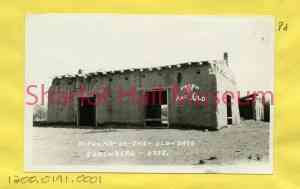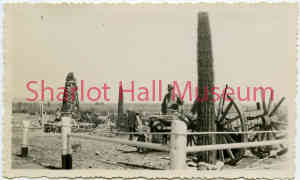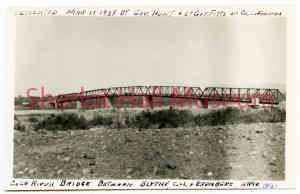by Kathy Lopez

Williamson Valley’s history of the mid-1860s could be told as a “Tale of Two Toll Roads” with Hardyville Road playing the major role in the communities of Walnut Creek and Williamson Valley. Ehrenberg Toll Road takes the lead when southern Colorado River towns and American Ranch Stage Station in Mint Valley enter the narrative.
In 1858 Arizona's first gold rush began when Jacob Snively (surveyor, engineer, Texas Ranger and miner) led an expedition that discovered a deposit of gold on Gila River about 20 miles east of Yuma. Snively was involved, with Hermann V. Ehrenberg, in the discovery of silver in Castle Dome Mountains north of Gila City. From these beginnings, further discoveries of gold, silver and copper enticed prospectors up and down the Pacific Coast and throughout the southwestern US.
 The rush for gold spurred waves of US citizens and immigrants seeking their fortune and opportunities. This influx of newcomers attracted entrepreneurs who provided goods and services and who were usually the most successful at finding gold —in miners’ pockets. At a time when the world's money supply was based on gold, newly-mined gold provided economic stimulus far beyond the goldfields of Arizona. An 1870 Arizona Territory’s census noted settlers’ birthplaces as: 21 US states, Mexico, Sonora, Canada, New Brunswick, Nova Scotia, Sweden, Germany, France, Ireland, England, Scotland and Prussia. Arizona’s gold flowed around the world and much of that gold was spent on transportation of passengers and goods.
The rush for gold spurred waves of US citizens and immigrants seeking their fortune and opportunities. This influx of newcomers attracted entrepreneurs who provided goods and services and who were usually the most successful at finding gold —in miners’ pockets. At a time when the world's money supply was based on gold, newly-mined gold provided economic stimulus far beyond the goldfields of Arizona. An 1870 Arizona Territory’s census noted settlers’ birthplaces as: 21 US states, Mexico, Sonora, Canada, New Brunswick, Nova Scotia, Sweden, Germany, France, Ireland, England, Scotland and Prussia. Arizona’s gold flowed around the world and much of that gold was spent on transportation of passengers and goods.
In 1863 most migrants from the eastern US traveled to the newly formed Arizona Territory overland by wagon. Except for Canadian and Mexican immigrants, most immigrants traveled from their homelands by ship. Those landing in San Francisco and Los Angeles  purchased supplies before setting sail around the tip of Baja Peninsula, up the Gulf of California, to the mouth of the Colorado River and then upstream by paddle steamers. Those traveling via the Atlantic Ocean often sailed around Cape Horn at the southern tip of South America to the southern mouth of the Colorado River or the Pacific Coast. Larger seaworthy boats from San Diego and Los Angeles sailed up the Gulf of California to supply river-mouth ports. From there paddle steamers carried freight from the river’s mouth, south of Yuma, to various towns as far as 300 miles upstream. The townsites of Ehrenberg and Hardyville were stopping places for travelers heading for the Prescott area by foot, steed, wagon and stagecoach.
purchased supplies before setting sail around the tip of Baja Peninsula, up the Gulf of California, to the mouth of the Colorado River and then upstream by paddle steamers. Those traveling via the Atlantic Ocean often sailed around Cape Horn at the southern tip of South America to the southern mouth of the Colorado River or the Pacific Coast. Larger seaworthy boats from San Diego and Los Angeles sailed up the Gulf of California to supply river-mouth ports. From there paddle steamers carried freight from the river’s mouth, south of Yuma, to various towns as far as 300 miles upstream. The townsites of Ehrenberg and Hardyville were stopping places for travelers heading for the Prescott area by foot, steed, wagon and stagecoach.
Built in 1865, Ehrenberg Road led northeast to Camp Date Creek, Skull Valley and American Ranch stage station where it intersected with Hardyville Road which led to Prescott, Fort Whipple and beyond. The rough road, which ran through unsettled Indian Country, served both military and civilians along the route.
Large freight wagons were often linked together like train cars, with up to four wagons in tandem. Mules usually pulled them, although occasionally, slower oxen were used. A team consisted of four to twelve pairs of mules, and teams could be doubled up if needed on steeper hills. An iron “tire” strengthened huge wood-spoked wheels of heavy wagons. With perseverance, determined seekers can find traces of their passage in some remote regions of Arizona — ruts and swales (sloped channels) and even an occasional rock with rust marks from iron ground from metal tires of the many loaded wagons that passed along the route. Wagons usually traveled in groups for mutual support and to discourage attacks. Spoke wheels were huge, around five feet in diameter, with iron rims for strength.
Excerpt from Williamson Valley & Beyond: Prehistory-1870s by Kathy Lopez, published by Morgan Ranch Park Association, 2022.
“Days Past” is a collaborative project of the Sharlot Hall Museum and the Prescott Corral of Westerners International (www.prescottcorral.org). This and other Days Past articles are also available at www.archives.sharlothallmuseum.org/articles/days-past-articles/1 The public is encouraged to submit proposed articles and inquiries to dayspast@sharlothallmuseum.org Please contact SHM Research Center reference desk at 928-277-2003, or via email at archivesrequest@sharlothallmuseum.org for information or assistance with photo requests


